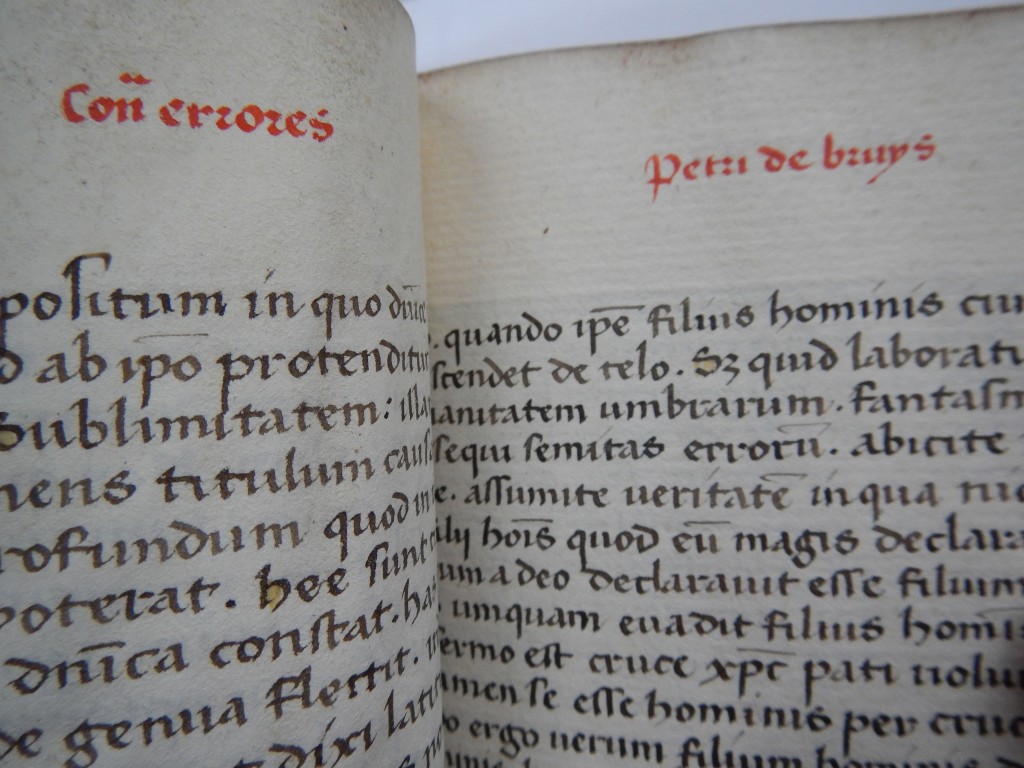Mildred Budny
(Research Group on Manuscript Evidence)
“Double Act: Manuscripts Combining Paper and Parchment”
Abstract of Paper
Presented at the 51st International Congress on Medieval Studies (Kalamazoo, 2016)
Session on
“Parchment or Paper? Choosing the Writing Medium in the Era Before the Printing Press”
Session 5 (2016) in the Research Group Series on “Medieval Writing Materials”
Sponsored by the Research Group on Manuscript Evidence
Organized by Mildred Budny
2016 Congress Program and 2016 Congress Report
[Published on 2 April 2016 with updates]
Some “Double Acts” in book form combine parchment (or vellum) and paper for their writing surfaces. In considering the transition — but not totally accomplished, with continuing points of overlap in practice to this day — between parchment and paper in Western Europe with the introduction also of printing, by blocks and moveable type, I offer some reflections about particular approaches in a selected set of cases pertaining to books, both manuscript and printed.
This exploration is not an exhaustive survey. Rather, we consider some highlights and touchstones which signal deliberate discernible choices.
The haphazard, random, or even, shall we say, “desperate” mixtures of paper and vellum, as the makers of various books drew from one and the other material in completing their tasks, may form the subject for other studies. So, too, are the mixtures of separate “booklets” or sections in composite volumes, with one wholly on paper and another, made at a different time and/or place, on vellum. Likewise, very many cases survive of books on paper which reuse medieval parchment leaves, bifolia, or scraps as all or part of their bindings or wrappers. These range from the covers and spines for wooden or paste boards, through limp vellum bindings, to stiffeners or liners for the backs of the books.
Cases of the former combinations (the Haphazard Method) and of the latter (the Post-Production Assembly Method) are multiple, and deserve consideration, but some cases exhibit a clearly planned combination of vellum and paper for organizational, even decorative, effect. These amount to “genuine” Double Acts.
The star of the show for today is a composite volume from Parc Abbey, near Louvain, in what is now Belgium. It does not appear in the list of The Surviving Manuscripts and Incunables from Medieval Belgian Libraries (2009).
Now in private ownership, the volume combines Parts I and II bound together in a typical 18th-century binding of this Premonstratensian abbey (abolished in 1796), with covers of brown calf over cardboard, a gold-tooled title on the spile, the gold-tooled arms of Parc Abbey (mostly effaced) at the center of both covers, and the abbey library pressmark on its front endpaper. The volume joins two different manuscripts (“Parts A and B”) containing respectively texts by ‘Albertus Magnus’ (apparently Hugo Ripelin of Strasburg) and Peter the Venerable in mid-15th-century script. A mid-17th-century printed catalogue of the library records those texts as two separate items. Mostly on paper (with several different watermarks), the Parts include elements of vellum at strategic positions.
Part A on paper employs scraps of reused vellum cut from some manuscript or other to strengthen the backs or “innards” of several quires. [Or so I thought, mislead by the typescript description of the volume by a prominent codicologist, when I first planned the Paper and wrote this Abstract. There remain some darkened paste stains at such points, but only a small scrap of a reused paper manuscript, so this Part of the Volume does not qualify for the selected theme.]

Paste stains between folios 7v – 8r in Quire 1 of Albertus Magnus text in Le Parc Abbey Volume. Photography © Mildred Budny
Part B is a notable specimen of “Double Action”, in an unusual, and regular, combination of vellum and paper leaves in each quire. Its reasons for combination may be mysterious, but the effect is stately, and worthy of notice.
*****
A fuller Report of this “star” manuscript appears in our blog on Manuscript Studies. See its Contents List. The volume is Number 15 in the Illustrated Handlist of Medieval and Early Modern Manuscripts, Documents, and Printed Materials.
*****
*****
Abstracts of Other Papers by Mildred Budny for our Sessions and Events appear here:
“Introduction to the Symposium: The Back & Forward Story” at the 2016 Symposium on “Words & Deeds”
Budny (2015 Congress)
Budny (2014 Congress)
“When the Dust Has Settled”
“Recollections of the Past”
“Identity and Authenticity”
*****




